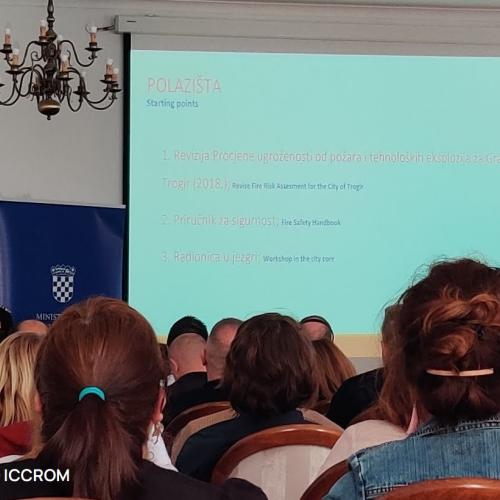PREVENT – Mitigating Fire Risk for Heritage
PREVENT – Mitigating Fire Risk for Heritage, was a participatory and multidisciplinary learning opportunity that looked at all sources of fire, both natural and manmade. It was based on workshops and field surveys carried out by ICCROM and its partner organisations, and led by fire risk prevention specialists, cultural first aiders, firefighters and emergency response agencies. The five-day workshop took place from November 15 to November 19, 2021, and was organized within the framework of First Aid and Resilience in Times of Crisis, a flagship programme of ICCROM. The participants of the course included 9 teams from 8 countries, namely Brazil, Canada, Chile, Croatia, Ireland, Israel, Nigeria and Palestine.
To highlight the PREVENT course participants’ case studies and share best practices the ICCROM’s First Aid and Resilience for Cultural Heritage in Times of Crisis Programme joined efforts with the Ministry of Culture and Media, the Republic of Croatia and the City of Trogir in organizing PREVENT - Mitigating Fire Risk for Heritage, an international hybrid symposium followed by a national capacity development workshop in Trogir, Croatia in October 2022. It was supported by the Croatian Fire Association, the Public Fire Brigade of the City of Trogir, as well as the PREVENT project partners, the Estonian Rescue Board, the Italian National Fire Corps (Corpo Nazionale dei Vigili del Fuoco – CNVVF) and the Swedish National Heritage Board.
The participants from the PREVENT course shared success stories in their local contexts, as well as lessons learned in the post-training project implementation phase from museums in Brazil, Canada, Chile and Israel; a royal palace in Nigeria; the Church of the Nativity in Palestine; the Newbridge House and Banff Park in Ireland; and even the symposium host city - Trogir. They highlighted the effectiveness of the PREVENT course by showing how these heritage places have benefitted from course alums’-built capacity to reduce fire risk to heritage and enhance emergency preparedness.
The symposium brought together more than 600 professionals from 89 countries, coming from diverse fields and contexts: from academia to government agencies, museums and youth organizations. Participants shared their valuable insights and perspectives on the vulnerabilities that create fire risks for heritage. The Symposium also enabled direct interaction with experts drawn from fire risk management, cultural heritage, and civil protection. Interactive sessions allowed all attendees to join the growing network of cultural first-aiders around the world.
Multi-disciplinary experts representing cultural heritage professionals, fire-risk specialists and national defence experts from Croatia, Estonia, Italy, Sweden, Australia, and the United States shared their evidence-based examples on fire-risk mitigation and highlighted the importance of interdisciplinarity in promoting fire safety and risk reduction.
A round table provided an interactive platform to the teams of cultural heritage professionals and fire risk experts from the first PREVENT workshop. A series of questions, polls and interactive word clouds engaged the live and online audience in the discussion. Their shared experiences showcased an array of similar challenges around the world, such as the intensifying wildfires caused by climate change, the lack of resources and capacities to safeguard heritage and the coordinated implementation of prevention and mitigation measures. Areas for improvement identified to reduce disaster risks at heritage places around the world included building and fire safety codes that consider heritage-specific needs, enhanced communication about risks among stakeholders and community engagement.
Following the symposium, participants Jasna Popovic and Marin Buble, led by the ICCROM-FAR team, organized the first three-day national PREVENT workshop in Trogir, Croatia. With hands-on activities, on-site exercises and interactive sessions, 45 participants in teams of cultural heritage professionals and fire risk experts, learnt about safeguarding heritage from fire risks and enhancing overall preparedness. The three-day training concluded with a multi-actor simulation of fire at the Saint Dominican Monastery in Trogir, Croatia.
Coming soon! ICCROM will collect all the stories of change achieved on the ground in eight countries and will share them as a new ICCROM publication, to be released in 2023.
Authors: Aparna Tandon, Senior Programme Leader for the FAR Programme and Sustaining Digital Heritage Programme of ICCROM and Jui Ambani, Programme Assistant for Disaster Risk Reduction and Climate Action for the FAR Programme.
